|
Today in New Orleans History |
|
|
April 27


 It was under construction from 1964 to 1968,
at a cost of $25 million. By 1994, this building was estimated to be worth $300 million. The Rivergate had pedestrian
entrances on Canal and Poydras Streets and Convention Center Boulevard. The South Peters Street elevation was dedicated
to entrance and exit openings for the two-level subsurface 800-automobile parking garage, a long loading dock with two
access doors 20' x 20' to the first floor, and freight elevators. The caption for the postcard (above) reads: The
RIVERGATE, which covers six city squares, located where famed Canal Street meets the Mississippi River, is one of the most
uniquely constructed convention-exhibition halls in the country. Boasting 130,000 square feet of clear, unobstructed space,
with no posts or pillars; it is capable of seating more than 16,000 persons for an assembly or meeting with 733 - 10'
x 10' exhibit spaces, or a combination of both. This 13 1/2 million dollar ($13,500,000) structure will be one of the
nation's newest and finest facilities". Ground breaking ceremonies on December 4, 1964 were followed
by the driving of piles and a deep excavation to provide space for the parking garage, mechanical and electrical equipment,
stairs and escalators to move people from subsurface levels up to the first floor, and the tunnel 60' x 750' ($1.3
million). Although the Rivergate was conceived and designed as a convention-exhibition facility, it was also used
as the venue for Mardi Gras balls, high school graduations, and the lying in state of New Orleans native Mahalia Jackson
in 1972). But like the Municipal Auditorium, the Rivergate became obsolete in its usefulness as a convention and exhibition
center. The Ernest N. Morial Convention Center was being planned in 1978. As of 2006, it has about 1.1
million square feet of exhibit space, covering almost 11 blocks, and over 3 million square feet of total space. It
is the 5th-largest facility of its kind in the United States and would dwarf the old Rivergate. The
City of New Orleans then altered the zoning ordinances to allow construction of a casino at the Rivergate site.
The city issued a call for casino proposals due on August 14, 1992 which required a $50,000 payment for the privilege
of submitting a proposal, half of which was refundable to unsuccessful bidders. On November 5, 1992, Mayor
Sidney Barthelemy and the City Council picked Christopher Hemmeter-Caesar's Palace (known as the Grand Palais group) to lease
the city-owned Rivergate site for development of a casino. The lease was signed on April 27, 1993. Subsequently,
the Casino Board awarded the casino operator's license to Harrah's Jazz, a partnership of Harrah's and the Jazzville group
(all local investors). On April 15, 1993, Mayor Barthelemy and the City Council finalized the selection of
Hemmeter as the "developer" -- he later teamed with Caesar's World of Las Vegas to operate the casino in a renovated
Rivergate but soon the Hemmeter-Caesar's group proposed its demolishion to make way for a new building called Grand Palais.
This plan would include a twenty-two-inch deep pond, called Celebration Lake which would run across the foot of Canal
Street, ending at One Canal Place. And there would be a sound and laser-light show and much more including a recreation
of Bernard the colonnaded arcades at the Palace of Fine Arts in San Francisco. In the end, the only elements of the
Grand Palais scheme that were constructed were the "Casino Support Facility" -- a ten-leve, 2 1/2 block long
parking garage) which replaced a group of nineteenth-century buildings at the corner of Poydras and South Peters Streets
and the tunnel linking it to the casino. But everything else fell through. The official "wall-breaking"
ceremony took place on Friday, January 13, 1995. On this occasion, a back hoe equipped with a claw toothed bucket and
a "Harrah's" banner draped on its back climbed up the steps at the Canal-South Peters Streets entrance and began
wrecking the underside of the cement plaster entrance canopy. Much of the concrete debris was hauled to West
End at Lake Pontchartrain to be used as fill for enlargement of a park off Breakwater Drive. Although only reinforced
concrete was supposed to be dumped there, other debris was included. The nature of the debris stirred environmentalists
and their protests stopped the dumping at the West End site. On October 28, 1999, Harrah's Casino was completed
at the foot of Canal Street, three years behind schedule. From THE RIVERGATE (1968 - 1995) Architecture And Politics -- No Strangers In Pair-A-Dice  

To receive an update for each day in New Orleans
history, join our facebook page
- Today in New Orleans History
Born in New Orleans on November 7, 1922, Alois Maxwell Hirt, son of NOPD officer Alois Sr. and Linda
Goupe, grew up at 1643 Mandeville Street. He began earning musical awards for his trumpeting acumen while a student at Jesuit
and Fortier. He played in the Junior Police Band with the children of Alcide Nunez, and by the age of 16, was playing professionally,
often with his friend Pete Fountain. During this time, he was hired to play at the Fair Grounds, beginning a six-decade connection
to horse racing. In 1940, he studied at the Cincinnati Conservatory of Music with Dr. Frank Simon (a
former soloist with the John Philip Sousa Orchestra). Hirt is pictured on the right at age 18 in an advertisement for Werlein's
on December 18, 1940. After a stint as a bugler in the United States Army during World War II, Hirt
performed with various Swing big bands, including those of Tommy Dorsey, Jimmy Dorsey, Benny Goodman, and Ina Ray Hutton.
In 1950, he became first trumpet and soloist with Horace Heidt's Orchestra. Upon his return to New
Orleans, he worked with various Dixieland groups and lead his own bands including Al Hirt's Dixieland Band -- of which Pete
Fountain was a member until taking a job in the late 1950s to be on the cast of the Lawrence Welk Show. During the early 50s,
he was on staff as the orchestra leader for WWL. During the 50s and 60s he was a regular at Pier 600 on Bourbon at St. Louis
Street. In 1962 Hirt opened his own club on Bourbon Street in the French Quarter, which he ran until 1983. His
fame was growing and he was sometimes called "Gabriel of the South". In 1958 he and Fountain appeared together
on the Lawrence Welk show. On August 12, 1960, Al Hirt and his Swingin' Dixie's were featured at Jazz Fest. On February 26,
1961 he and his band played on the Dinah Shore Show. He was now being called "King of Trumpets". Twenty two of his albums were on the Billboard charts in the 1950s and 1960s. The albums Honey In The
Horn and Cotton Candy were both in the Top 10 best sellers for 1964, the same year Hirt scored a hit single with his cover
of Allen Toussaint's "Java" (Billboard No. 4), and later won a Grammy Award for the same recording. Both Honey
in the Horn and "Java" sold over one million copies, and were awarded gold discs. He recorded the theme for the
1960s TV show "The Green Hornet", which re-gained public attention in 2003 when it was used in the film Kill Bill. In 1967 Hirt became one of 18 minority owners (Hirt had 2.5%) of our brand
new NFL expansion team, the New Orleans Saints. He is pictured (left) on September 12 1967 playing to Gumbo, the Saints' mascot,
at a Jung Hotel luncheon for coaches and players before the kickoff of the first season. Gumbo had been a gift to the
team by the Louisiana Restaurant Association. Hirt was the musical director for the Saints and played the National Anthem
at the first season game, five days later on on September 17. Hirt became a fixture at Saints games,playing his horn
for fans as often as possible. Gumbo's descendant, Gumbo IV was fired in November 1985, now replaced by a human dressed in
a St. Bernard costume. The photograph is by J.W. Guillot/Times-Picayune archives. On February
7, 1970, while riding in the Bacchus parade, he was struck by a hurled brick, rock, or cement chunk (sources vary) which left
him bleeding profusely and the needing 12 (or 16, sources vary) stitches across the entire underside of his upper lip. He
was taken from the float, rushed to Baptist Hospital, treated, and then attended the krewe's ball at the Rivergate the same
evening. He was forced to cancel two upcoming performing commitments and await the healing process to know if he would
ever be able to play the trumpet again as he did in the past. His career was seriously threatened and the public was
outraged, calling for the end this sort of violence that had occured at many other parades during that Carnival season. The
story made national news. This incident was parodied in a Saturday Night Live skit from their second season Mardi Gras
special, the "Let's Hit Al Hirt in the Mouth with a Brick Contest" |
|
|

To receive an update for each day in New Orleans history,
join our facebook page - Today in New
Orleans History.
Analytics |
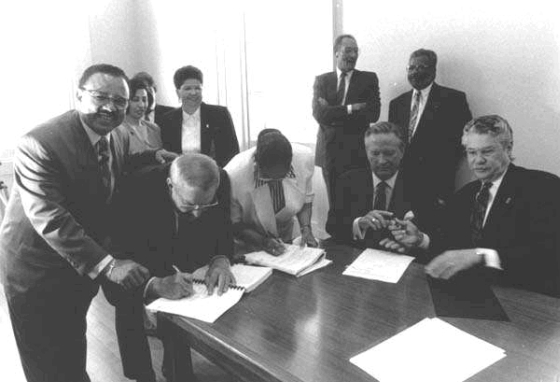
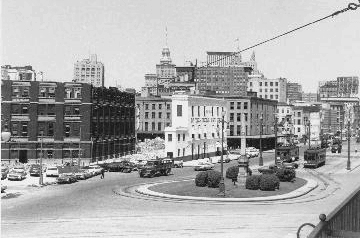
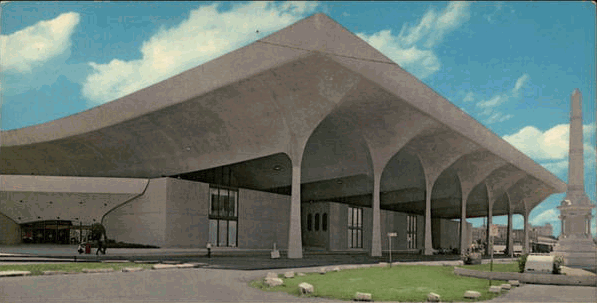 The Rivergate was designed by the local firm Curtis and Davis (Nathaniel Cortlandt Curtis Jr. (1917–1997) and Arthur
Quentin Davis (1920–2011) who had also designed the Thomy Lafon School (1954) and the Louisiana State Penitentiary
at Angola (1956) and would later design the Superdome. The undulating forms of the Rivergate's thin barrel
vaults were not whimsical but are the precise shape necessary to manage the unusually long spans required for the roof
over the column free space below. The cantilevers all around contribute to the stability of the roof structure. The selection
of six temple like bays utilized to the limit the spans between columns; the columns themselves are slender and graceful,
suited to the task of support. The Rivergate, while it stood in New Orleans, was looked upon by many as a significant
example of outstanding national and international contemporary architecture and was compared to the recognized masterpieces
of its period. The most distinguishing feature of the Rivergate was the roof. The 95,500-sq. foot South Hall
was covered by a swooping and sweeping dual curved roof. This reinforced concrete barrel-arched roof design was symbolic
of the rolling Mississippi River which flows about 500 feet from the building. Engineering News Record referred to
these "humpbacked" 1-1/2 catenary curve barrel arches 453 ft. long as having the profile of a whale. The Rivergate
roof was perhaps the longest thin shell concrete roof span that had been constructed at that time. The 34,500-sq. foot
North Hall, later called Penn Hall, in honor of its distinguished and successful manager, Herman Penn, was spanned
by steel trusses 6' deep and covered with a flat roof.
The Rivergate was designed by the local firm Curtis and Davis (Nathaniel Cortlandt Curtis Jr. (1917–1997) and Arthur
Quentin Davis (1920–2011) who had also designed the Thomy Lafon School (1954) and the Louisiana State Penitentiary
at Angola (1956) and would later design the Superdome. The undulating forms of the Rivergate's thin barrel
vaults were not whimsical but are the precise shape necessary to manage the unusually long spans required for the roof
over the column free space below. The cantilevers all around contribute to the stability of the roof structure. The selection
of six temple like bays utilized to the limit the spans between columns; the columns themselves are slender and graceful,
suited to the task of support. The Rivergate, while it stood in New Orleans, was looked upon by many as a significant
example of outstanding national and international contemporary architecture and was compared to the recognized masterpieces
of its period. The most distinguishing feature of the Rivergate was the roof. The 95,500-sq. foot South Hall
was covered by a swooping and sweeping dual curved roof. This reinforced concrete barrel-arched roof design was symbolic
of the rolling Mississippi River which flows about 500 feet from the building. Engineering News Record referred to
these "humpbacked" 1-1/2 catenary curve barrel arches 453 ft. long as having the profile of a whale. The Rivergate
roof was perhaps the longest thin shell concrete roof span that had been constructed at that time. The 34,500-sq. foot
North Hall, later called Penn Hall, in honor of its distinguished and successful manager, Herman Penn, was spanned
by steel trusses 6' deep and covered with a flat roof. 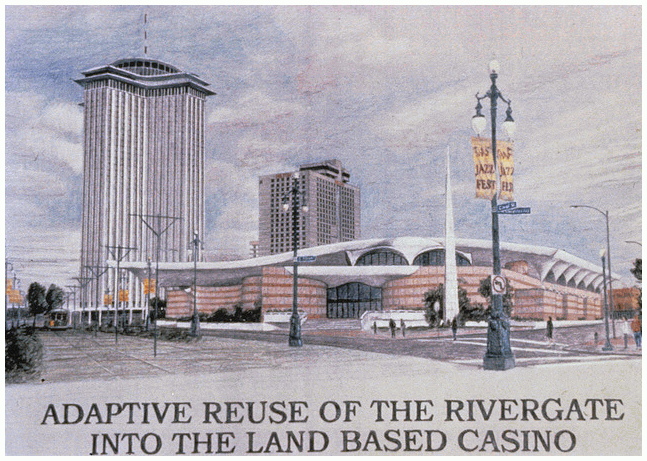 In June 1992, Louisiana House Bill 2010 (Act 384 of the 1992 Regular Session) authorized a land-based casino in New Orleans.
The legislation specifically defined the location of the land-based casino -- the Rivergate site at the foot of Canal
Street. The law did not require the Rivergate to be torn down, and it did not require a new casino to be built.
In June 1992, Louisiana House Bill 2010 (Act 384 of the 1992 Regular Session) authorized a land-based casino in New Orleans.
The legislation specifically defined the location of the land-based casino -- the Rivergate site at the foot of Canal
Street. The law did not require the Rivergate to be torn down, and it did not require a new casino to be built.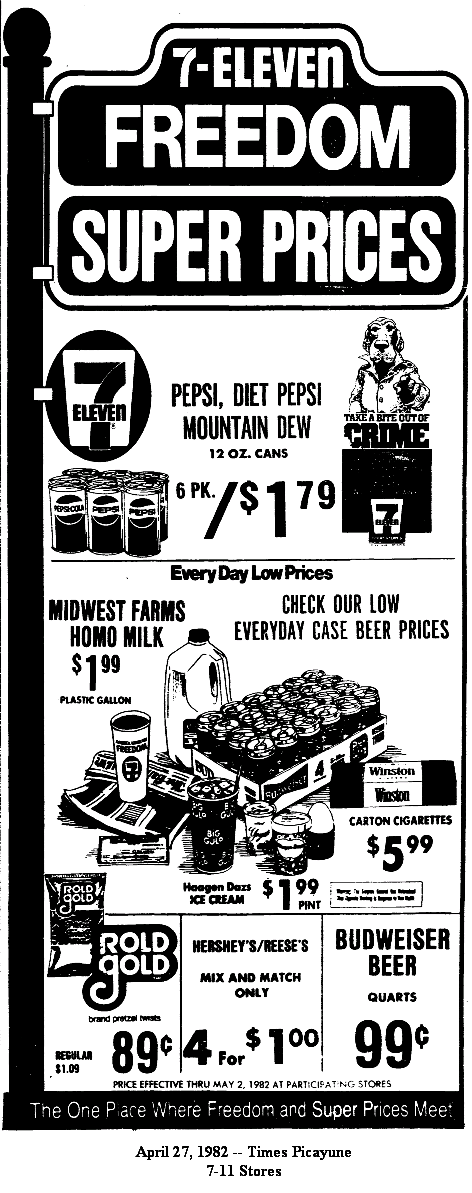
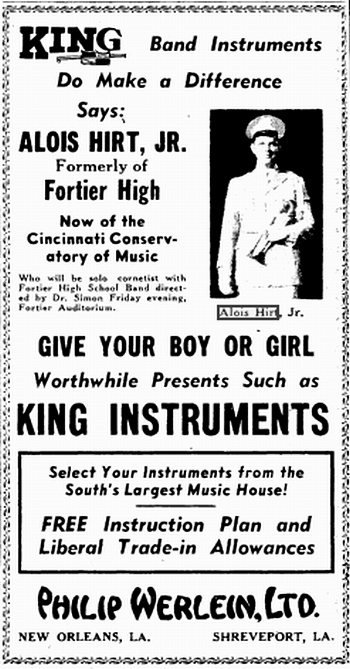
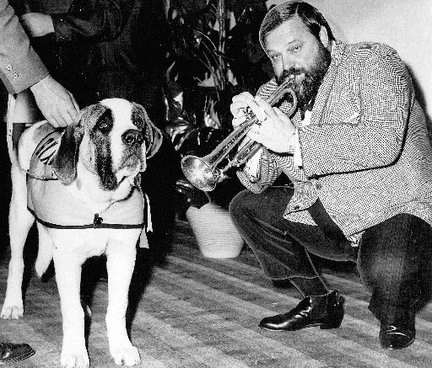 "Jumbo" and Gumbo
"Jumbo" and Gumbo
